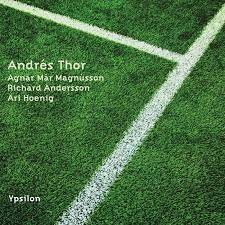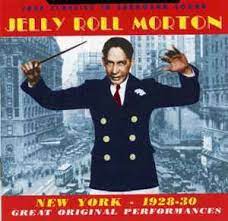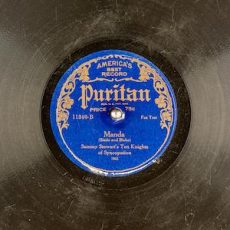
Daily Dose Of Jazz…
Dick Lammi was born on January 15, 1909 in Red Lodge, Montana. Early in his career he played violin and banjo, playing as a banjoist in various dance bands and orchestras in the Pacific Northwest in the late 1920s. Settlling in Portland, Oregon in the early Thirties, and played bass in a group there.
After a move to San Francisco, California in 1936 he began playing tuba alongside bass. His best-known work was as a member of Lu Watters’s rehearsal band, which evolved into the Yerba Buena Jazz Band, playing regularly at the Dawn Club.
With World War II interrupting his tenure with the ensemble, after his discharge he rejoined the YBJB and stayed with them until they disbanded in 1950. The Fifties saw Dick working with Bob Scobey, Turk Murphy, Wally Rose, and Clancy Hayes. He recorded little after the early 1960s.
Tubist and bassist Dick Lammi, who was the first tuba player to record during the San Francisco revival, died on November 29, 1969 in San Francisco.
More Posts: banjo,bass,history,instrumental,jazz,music,tuba,violin

Daily Dose Of Jazz…
Eugene Chadbourne was born January 4, 1954 in Mount Vernon, New York but grew up in Boulder, Colorado. He started playing guitar when he was eleven or twelve, inspired by the Beatles and hoping to get the attention of girls. Although he was initially drawn to Jimi Hendrix and played in a garage band, he found rock and pop music too conventional. Gravitating to the avant-garde jazz of Anthony Braxton and Derek Bailey, it was the former musician who persuaded him to abandon his journalism endeavors and pursue music.
During the early 1970s, he lived in Canada to avoid military service in the Vietnam War. Returning to the United States, he moved to New York City and played free improvisation with Henry Kaiser and John Zorn. Around this time, he released his first album, Solo Acoustic Guitar. In the early 1980s, he led the avant-rock band Shockabilly with Mark Kramer and David Licht.
He explored other genres, playing with a Cajun band, a Russian folk band and mixed country, western, and improvisation in the band LSD C&W. For many years Eugene was in a duo, and then worked with Han Bennink, Fred Frith, Elliott Sharp, and Charles Tyler..
Chadbourne invented an instrument known as the electric rake by attaching an electric guitar pickup to a rake. He played a duet of electric rake and classical piano with Bob Wiseman on his 1991 album Presented by Lake Michigan Soda. He also played the instrument on a Sun Ra tribute album.
Banjoist, guitarist and music critic Eugene Chadbourne, who has recorded 39 albums as a leader, continues to perform and record.
More Posts: bandleader,banjo,critic,guitar,history,instrumental,jazz,music

Daily Dose Of Jazz…
Andrés Thor was born on December 27, 1974 in Hafnarfjordur, Iceland, a little harbour town near Reykjavík, Iceland. He began his musical studies at age 12 and his initial influences were glitter and hippie rock bands such as Led Zeppelin, The Doors, Jimi Hendrix and Bon Jovi.
During his teens was when he first heard the music of John Coltrane and Pat Metheny which led him to become more fascinated with jazz. He soon started studying with some of Iceland’s finest jazz educators at the FIH music school and after graduating his musical quest brought him to study at the Koninklijk Conservatorium (The Royal Conservatory) in The Hague, The Netherlands in 2000.
Finishing his Bachelors and Masters degrees by 2006 he went on to study under the guidance of Wim Bronnenberg, Peter Nieuwerf, Eef Albers, John Ruocco and Hein v/d Geyn as his main teachers. He also attended workshops and masterclasses lead by Michael Brecker, Kurt Rosenwinkel, John Abercrombie and Avishai Cohen, as well as performing with the late Michael Brecker and the Royal Conservatory Big Band in concert.
Living and studying in the Netherlands lead to the first recording featuring Andrés as a co-leader of the organ trio Wijnen, Winter & Thor. The band featured songs by all members of the trio. Since then he has been based and working in and out of Iceland and has released five albums under his own name and a handful of albums in collaboration. He has been active in various collective projects and as a sideman with bands like ASA trio, Icewegian, The Viking Giant Show, BonSom, Andreas Dreier quartet and Music with Z to name a few.
Thor has been an active performer in Scandinavia, Europe and America, as well as a session musician in studios and educator in Iceland. He doubles on the mandolin, banjo and steel guitars. Guitarist Andrés Thor continues to record and perform blending his positively ambrosial tonal palette with the elegant harmonic substance and incisive, ornamented cross-rhythms.
More Posts: banjo,guitar,history,instrumental,jazz,mandolin,music

Daily Dose Of Jazz…
Lee L. Blair was born on October 10, 1903 in Savannah, Georgia and was a left-handed autodidact on banjo, aside from a few lessons taken from Mike Pingitore, the banjoist for Paul Whiteman. He played and recorded in New York City, New York with Thomas Morris’s Seven Hot Babies in 1926, then played with Charlie Skeete in 1926-28, before playing and recording with Jelly Roll Morton’s Red Hot Peppers in 1928-30.
In the Thirties he went on to play with Billy Kato, then played and recorded with Luis Russell and Louis Armstrong from 1935 to the end of the decade. He worked part-time in music through the 1940s, then joined Wilbur De Paris’s New New Orleans Jazz Band in the 1950s at Jimmy Ryan’s Club on West 52nd Street in New York City.
The summer of 1957 had him touring Africa with the DeParis band for the State Department. During the 1960s he played less, concentrating on raising chickens on his farm in Belmore, Long Island, but appeared at the 1964 World’s Fair in a trio with Danny Barker and Eddie Gibbs. He freelanced around New York with Hank Duncan and others until his death.
He never recorded as a leader, but appears on record with Morris, Morton, Russell, Armstrong, and De Paris, as well as with Dick Cary, Pee Wee Erwin, and Leonard Gaskin among others. He is honored in the jazz section of the Georgia Music Hall of Fame in Macon, GA.
Banjoist and guitarist Lee Blair, who never recorded as a leader, transitioned on October 15, 1966 in New York City.

Daily Dose Of Jazz…
Lawrence William “Beau” Dixon was born on September 5, 1894 in Chillicothe, Ohio, the second of five children. His father was a farm laborer and part-time musician, from whom he learned to play music from an early age.
From 1923 to 1928 he played in Chicago, Illinois and Columbus, Ohio with Sammy Stewart’s Ten Knights of Syncopation, which recorded for Paramount Records. During the Twenties Beau also worked with Vance Dixon’s Jazz Maniacs, Fess Williams, Dave Peyton, Paul Jordan, Clarence Moore, and Grant Williams.
In 1931 he joined Earl Hines’s band and remained with him until 1937 as rhythm guitarist and arranger. Dixon worked with Franz Jackson’s Original Jass All Stars in the Chicago area in the 1950s and 1960s.
Banjoist and guitarist Beau Dixon, who suffered for years with pulmonary emphysema and tuberculosis, transitioned on January 16, 1970 in Chicago.





